
Donneloye Castle is a manor house in the municipality of Donneloye of the Canton of Vaud in Switzerland. It is a Swiss heritage site of regional significance. [1]

Donneloye Castle is a manor house in the municipality of Donneloye of the Canton of Vaud in Switzerland. It is a Swiss heritage site of regional significance. [1]

Little is known of the history of the manor of Donneloye in the Middle Ages. The last scion of the autochthonous family, Othenin de Donneloye, died circa 1387 without male issue: it is not known if a castle then existed in the village, but it seems probable.
The manor passed to Edouard de Provana, of a northern Italian family, who in 1386 married Marguérite de Donneloye, daughter of Othenin, and in 1440 Jacques de Glâne, lord of Villardin and de la Molière, and his descendants possessed it until 1528, when Catherine de Glâne married Aubert Loys. The manor was then split, and the castle acquired by the family of Roguenet (or Regnault) de Romont, who apparently made important architectural alterations to the edifice.
Before 1600 Petterman d'Erlach (1579-1635), a Bernese catholic, inherited the castle by his marriage to Marguerite Roguenet, and on his death it passed to a distant relative, colonel Louis von Roll (1605-1652) of Soleure (Solothurn), who made further substantial alterations, evidenced by an inscription dated 1639 on the south façade. On Von Roll's death his widow, Claire de Vallier, sold the building to Jean-Philippe Loys (1622-1676). Loys, an influential landowner and politician in the region, reintegrated the manor, acquiring the rights and lands which had been detached since 1528. It was probably during the tenure of Loys that the windows on the first floor were enlarged, around 1660. In 1711 the Bernese, who had long wanted to acquire the manor because of its strategic position between Yverdon and Moudon, managed to persuade Loys' descendants to sell the rights, customs and usages, the family retaining the castle, the right to dispense justice to the inhabitants of Donneloye and other nearby villages, and to maintain a prison, no doubt the tower near the castle. The castle from then on seems to have been little used and fell into disrepair, the Loys family choosing to live on their estates in Moudon and Lausanne.
On the death of Jean Loys in 1739 the castle passed to his son Georges, lord of Orzens, who died without issue in 1753, and then to his brother Paul (died 1784), subsequently to Paul's son Etienne-Charles, the last lord of Villardin, who died without issue in 1800. Etienne-Charles' nieces, Duval de la Pottrie then acquired the castle, but soon sold it to Louis Durussel, a local landowner, whose family maintained it until 1889 when it was sold to Jacques-François Viquerat (1838-1904), conseiller d'état and mayor of Donneloye. One of Viquerat's charges was the preservation of historic monuments: instrumental in the restoration of the Château de Chillon and of Lausanne Cathedral, he also restored his residence at Donneloye in 1902. Several unfortunate additions and alterations of the 1950s have since been eliminated.
Built just south of the parish church, the castle was once surrounded by substantial lands and curtilages, all now lost, with the exception of the granary to the east, and the massive medieval tower to the south of the former courtyard, which was enclosed by a wall, now extant only along the road. The castle was erected in several stages: dendrochronological research dates one of the earlier beams to 1434/5, [2] and by the 16th century it had taken on its current layout, including the imposing roof.
The building today consists of a principal rectangular body divided by a wide central corridor. There are three floors, the upper used as an attic since the raising of the ceilings, probably in the 17th century. There are no sculptures like those of the castle of Avenches, but it is a typical example of a rural medieval Savoyard manor house. The castle is currently (2020) in private hands. [3]
Luthi, Dave. Le Château de Donneloye: étude historique. Bureau de recherches en histoire de l'architecture, Lausanne 2002.

The Château de Chenonceau is a French château spanning the river Cher, near the small village of Chenonceaux, Indre-et-Loire, Centre-Val de Loire. It is one of the best-known châteaux of the Loire Valley.

The canton of Bern or Berne is one of the 26 cantons forming the Swiss Confederation. Its capital city, Bern, is also the de facto capital of Switzerland. The bear is the heraldic symbol of the canton, displayed on a red-yellow background.

Chillon Castle is an island castle located on Lake Geneva, south of Veytaux in the canton of Vaud. It is situated at the eastern end of the lake, on the narrow shore between Montreux and Villeneuve, which gives access to the Alpine valley of the Rhône. Chillon is amongst the most visited medieval castles in Switzerland and Europe. Successively occupied by the House of Savoy then by the Bernese from 1536 until 1798, it now belongs to the State of Vaud and is classified as a Swiss Cultural Property of National Significance. The Fort de Chillon, its modern counterpart, is hidden in the steep side of the mountain.
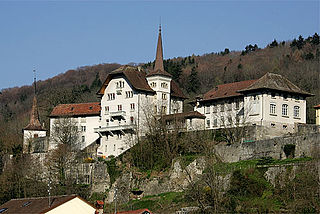
Moudon is a municipality in the canton of Vaud in Switzerland. It was the seat of Moudon District and is now in the Broye-Vully district.
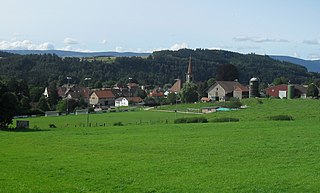
Donneloye is a municipality in the district of Jura-Nord Vaudois of the canton of Vaud in Switzerland.
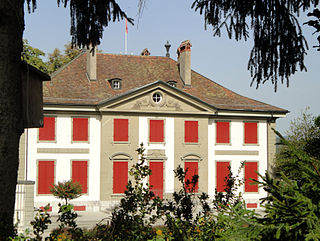
The Lohn Estate is a manor and estate located in Kehrsatz, canton of Bern, Switzerland. It serves as the official estate of the Swiss Federal Council. From 1942 to 1994, the Lohn Estate accommodated the official guests of the Swiss Confederation, which have included a number of heads of States and royalty. It is a Swiss heritage site of national significance.

The Castle of Gruyères, located in the medieval town of Gruyères, Fribourg, is one of the most famous in Switzerland. It is a Swiss heritage site of national significance.

Toffen Castle is a Baroque country estate in Toffen, Canton of Bern, Switzerland. It is a Swiss heritage site of national significance.
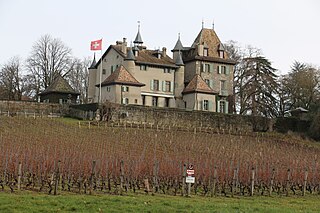
The Château Du Crest is a castle in the municipality of Jussy of the Canton of Geneva in Switzerland. It is a Swiss heritage site of national significance.

Château Saint-Maire is a castle in Lausanne, Switzerland, that serves as the seat of the cantonal government, the Council of State of Vaud. It is a Swiss heritage site of national significance.

Lucens Castle is a castle in the municipality of Lucens in the canton of Vaud in Switzerland. It is a Swiss heritage site of national significance.

Vufflens Castle is a medieval castle in the Swiss municipality of Vufflens-le-Château in the canton of Vaud. It is a Swiss heritage site of national significance.

Rolle Castle is a castle in the municipality of Rolle of the Canton of Vaud in Switzerland. It is a Swiss heritage site of national significance.
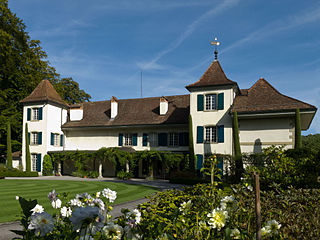
Bremgarten Castle is a castle in the municipality of Bremgarten of the canton of Bern in Switzerland. It is a Swiss heritage site of national significance.

The Château d'Ouchy is a hotel built on the site of an old medieval castle in Lausanne, Switzerland by fr:Jean-Jacques Mercier between 1889 and 1893.
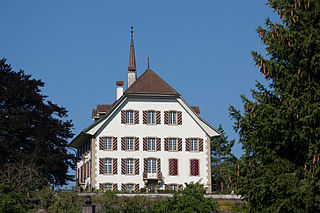
Riggisberg Castle is a castle in the municipality of Riggisberg of the canton of Bern in Switzerland.
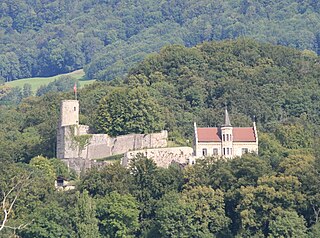
Bipp Castle is a partially ruined castle in the municipality of Oberbipp of the Canton of Bern in Switzerland.
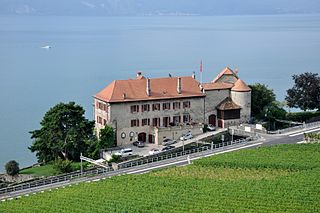
Glérolles Castle is situated in the municipality of Saint-Saphorin, canton of Vaud, Switzerland, on the northern shore of Lake Geneva. Its earliest elements date from a fortress built around 1150. The modern building serves as the headquarters for a vineyard of the same name, and as a venue which can be hired to host social events. It is a Swiss Cultural Property of Regional Significance.

The Château du Moisnil is a château or manor house of Wallonia, located in the village of Maizeret, municipality of Andenne, province of Namur, Belgium.

Pampigny Castle is a castle in the former municipality of Pampigny of the Canton of Vaud in Switzerland.
| Wikimedia Commons has media related to Château de Donneloye . |